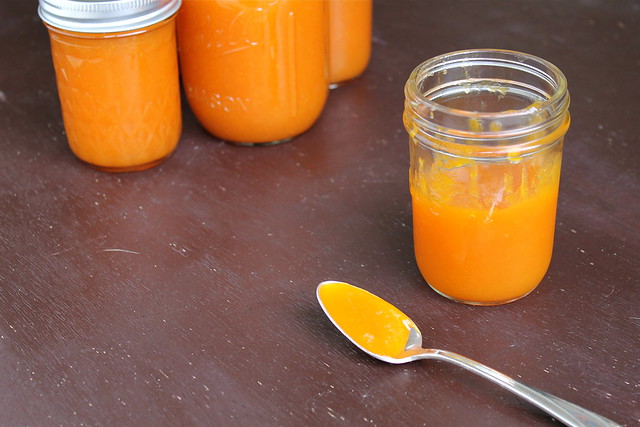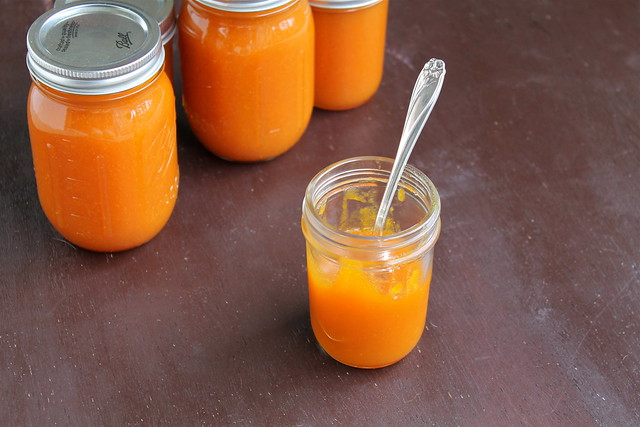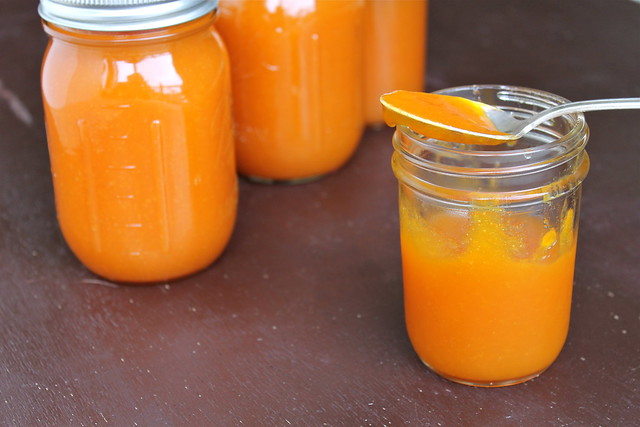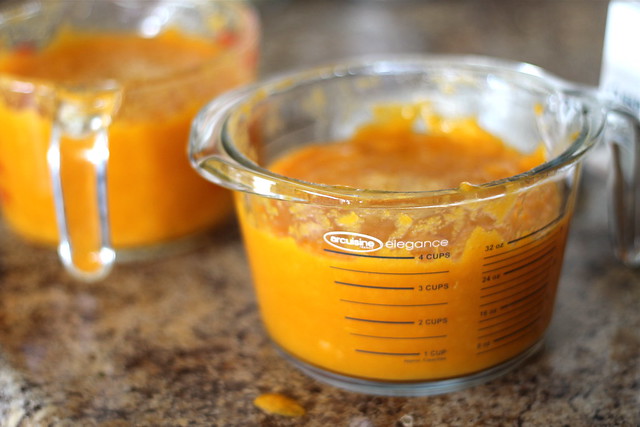Remember my friend with the apricot tree? Well, when I went over the other week to get some more fruit, her countertops were covered. You know those plastic tubs that baby spinach and salad greens come in? I think she had about six of those filled and overflowing with fragrant, golden fruit. So instead of coming home with a pound or two, I came home with eight.
It turns out that I don't love fresh apricots. I like them dried, but I love them turned into butter. If you think I went into raptures in past summers about peaches, well, you're right, but I went into bigger, louder raptures over this apricot butter. Obviously, Mr Official Taster thinks I'm nuts, but, you know what? More. For. Me.
Because this silky smooth apricot butter- this is ambrosia. This is legendary. This is why we have sliced bread.


Apricot Butter - vegan, gluten free, & free of just about everything else
This is one of those "guideline" recipes. Keep the ratios similar, and you can make bigger or smaller batches. The size of your apricots is going to make a difference- the ones I used were quite small, so even though I started with 7 pounds, the pits and the skins were a large percentage of that weight. Keep in mind that the bigger the batch, the longer the cook time.
A food mill is optional, but helpful. I used a hand-me-down from my mom, but Deb of Smitten Kitchen recommends Oxo's. This tastiness will be welcomed as gifts during the holidays (or anytime, really), especially if you present it along with some fresh bread.
Confession: I have an open jar in the fridge, and thus far it hasn't made it onto any bread. It's just gone from spoon to mouth.
Yield: I got 2 pints + 2.5 8-oz jars
7 lbs apricots
1 - 1.5 C water
approx. 2.5-3 C sugar
3 Tbsp lemon juice
The apricots need to be peeled at some point in this process. You have a couple of choices.
Without a food mill:
Option A) peel apricots with a paring knife.
Option B) Cut a small “x” in the bottom of each apricot. Dip each into a pot of boiling water for 30 seconds, and then into a bowl of cold water for a minute. The peels should slide right off. (If you have a food mill, skip the peeling step and keep reading.)
All together now:
Halve your apricots and remove the pits, then cut each half in half (i.e. 4 chunks from each apricot). Place apricot chunks and water in a large pot and bring to a boil. Simmer until apricots are tender, about 15-20 minutes, stirring occasionally to ensure they cook evenly.
At this point, if you have a food mill: working in batches, run apricot mixture through it to puree and remove the skins. If you have a large Pyrex measuring cup (or similar), try to puree the apricots directly into it. For this recipe, you need to measure the number of cups of puree you have. If you already peeled your apricots in Option A or B — you can puree them in a food processor, blender or with an immersion blender. I like my fruit butters quite smooth, but leave some chunks if you prefer.
Here is where everyone's batch is going to differ. Because the amount of sugar you need depends on the number of cups of puree you have. I ended up with 9.5 cups of apricot puree. The Ball book calls for 1/2 cup of sugar for every 1 cup of puree. I wanted less sugar, just like in my peach butter, so I used about 1/3 cup of sugar for every 1 cup of puree. If I were you, I would go with 1/4 - 1/3 cup of sugar for each cup of apricot puree, taste it, and add more if you'd like.
Return the apricot puree to your large pot, add the sugar, and bring the mixture to a good strong simmer/gentle boil. Cover if necessary to get them to a boil faster, but do NOT get distracted by a book in the other room. Cook them at this level for 60+ minutes, stirring occasionally in the beginning and more often near the end, as it thickens up and the fruit masses risk scorching on the bottom of the pot.
There are several methods to test for doneness: You can drizzle a ribbon of sauce across the surface; when that ribbon holds its shape before dissolve into the pot, it is done. Some people use cold or frozen plates; dollop a spoonful in the middle of one and if no water forms a ring around it in a couple minutes, it is done. Others use a spoon; if the butter remains rounded on a spoon for two minutes, it is done.
Return the apricot puree to your large pot, add the sugar, and bring the mixture to a good strong simmer/gentle boil. Cover if necessary to get them to a boil faster, but do NOT get distracted by a book in the other room. Cook them at this level for 60+ minutes, stirring occasionally in the beginning and more often near the end, as it thickens up and the fruit masses risk scorching on the bottom of the pot.
There are several methods to test for doneness: You can drizzle a ribbon of sauce across the surface; when that ribbon holds its shape before dissolve into the pot, it is done. Some people use cold or frozen plates; dollop a spoonful in the middle of one and if no water forms a ring around it in a couple minutes, it is done. Others use a spoon; if the butter remains rounded on a spoon for two minutes, it is done.
Stir in lemon juice.
If you’re not canning it, allow it to cool completely, and then keep it in an airtight container in the fridge. It should be good for at least two weeks. I think it should freeze ok.
To can your apricot butter: pour into hot, sterilized jars, leaving a 1/4-inch (6mm) head space. Wipe the rims clean. Seal according to manufacturer's directions. Process the jars in a boiling water bath for 10 minutes. Remove canner lid. Wait 5 minutes, then remove jars, cool, and store.
If you’re not canning it, allow it to cool completely, and then keep it in an airtight container in the fridge. It should be good for at least two weeks. I think it should freeze ok.
To can your apricot butter: pour into hot, sterilized jars, leaving a 1/4-inch (6mm) head space. Wipe the rims clean. Seal according to manufacturer's directions. Process the jars in a boiling water bath for 10 minutes. Remove canner lid. Wait 5 minutes, then remove jars, cool, and store.




Yummmmmy! My parents' apricot tree is ripe right about now too - this apricot butter brings back fond memories of making apricot jam with my grandma as a child. Thanks for the recipe!
ReplyDeleteoh fun! I'm glad I could spark some sweet memories. Maybe you can forage at your parents and make some of your own?
DeleteNow I really regret not buying all the apricots in the land at this weekend's farmer's market! Oh well--there's always next week. :)
ReplyDeletehaha, well, if you're really desperate I bet there's a mid-week one you could visit! Happy marketing :)
DeleteI'm making this right now and can't wait to see how it turns out! I'm new to canning and I've made pickles, apple butter, and 2 kinds of jam so far this week. It's so addicting!
ReplyDeleteYou've been busy! I made a ton of jam this year before I cut myself off. Enjoy!
Delete